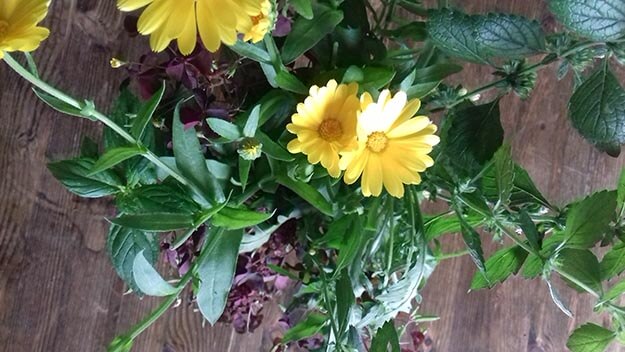
On August, 20th, Estonia celebrated the 26th anniversary of its reindependence, known as taas/ise/seisvusmis/päev (Reindependence Day). It landed on püha/päev (Sunday) this year, which meant no extra day off work… But happily, that will not be the case for the next 4 years. On that day, we also happened to be celebrating a mere mortal’s sünni/päev (birthday) and guests brought tokens of appreciation aka kingitused (gifts), including this söödav kimp (edible bouquet) from their backyard in the Kassisaba (Cat’s Tail) neighborhood of Tallinn.
The blossoms are yellow SAIA/LILL (calendula officinalis, pot marigold), which can be eaten in salads or as a garnish, tied around your sore finger, or dried for tea. Saia/lille petals (kroon/lehed) range from yellow to bright orange, they close their blossoms at night, and their name means “white bread flower” in Estonian. They are powerhouses of healing.
Extending outward are stalks of MELISS (melissa officinalis, lemon balm), which makes another yummy tea. Its relative PIPAR/MÜNT is on the left and beneath the õied (blossoms) are the long, lobed leaves of the maitse/taim (herb) Estonians call RUKOLA. It is native to the Vahemere (Mediterranean) region, and Italians call it rucola. In Britain and Australia it’s known as rocket (from the French roquette) and in North America, you call it arugula, which is also from an Italian dialect. The sõna/raamat (ye old book o’ words) claims its official Estonian name is põldvõõrkapsas (“field foreign cabbage”), which is misleading, since it belongs to the sinep (mustard) family, hence its pungent, strong flavor. But everyone calls it rukola here anyway. It has become extremely popular and commonplace, a great green vanad eestlased knew nothing about.
At the very bottom are the red leaves of punane JÄNESEKAPSAS (red wood sorrel), which people often mistake for ristik (clover) because of its leaves, and therefore also call it õnne/ristik (lucky shamrock). In this kimp (bouquet) we have the decorative, garden, redleafed variety; in the woods it’s green. Both are wonderfully sour and edible, as any karjane (shepherd) can attest to. Perfect in salads and soups. Practical is beautiful! Jätku! May there be enough to eat.
Photo and text: Riina Kindlam,
Tallinn














